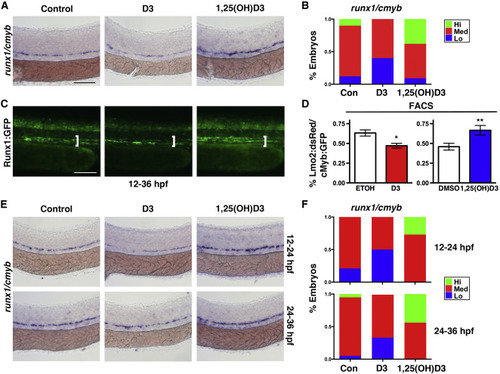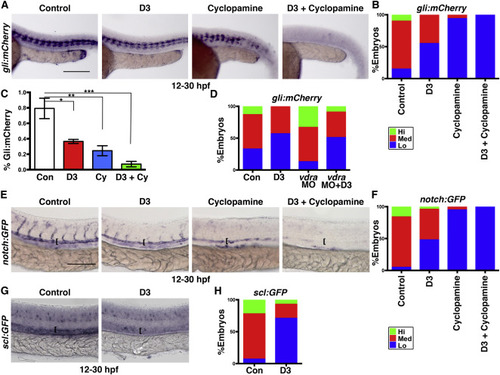- Title
-
Accumulation of the Vitamin D Precursor Cholecalciferol Antagonizes Hedgehog Signaling to Impair Hemogenic Endothelium Formation
- Authors
- Cortes, M., Liu, S.Y., Kwan, W., Alexa, K., Goessling, W., North, T.E.
- Source
- Full text @ Stem Cell Reports
|
Vitamin D Metabolites Have Differential Effects on HSC Formation (A) Exposure to D3 (50 μM) decreased runx1/cmyb expression by WISH at 36 hpf, and 1,25(OH)D3 (10 μM) increased expression. Scale bar, 100 μm. (B) Qualitative phenotypic distribution of embryos from (A) scored with low, medium, or high runx1/cmyb expression in the AGM (n > 50 embryos/condition). (C) Runx1:GFP embryos exhibited either diminished or enhanced expression with D3 or 1,25(OH)D3 exposure, respectively. Scale bar, 100 μm. (D) FACS analysis of double-positive HSPCs in Lmo2:dsRed/cMyb:GFP embryos confirmed a 25% (∗p = 0.014) decrease with D3 versus a 20% (∗∗p = 0.029) increase with 1,25(OH)D3 compared to controls (5 embryos/sample × 4 replicates/condition). Error bars, mean ± SD. (E) D3 treatment during hemogenic niche specification (12–24 hpf) or HSC induction (24–36 hpf) only decreased runx1/cmyb by WISH in the early exposure window, whereas 1,25(OH)D3 increased expression during either treatment period. Scale as in (A). (F) Qualitative phenotypic distribution of embryos from (E) scored for runx1/cmyb as in (B) (n > 20 embryos/condition). See also Figure S1. PHENOTYPE:
|
|
D3 Negatively Regulates Hh-Mediated Vascular Niche Specification (A) Gli:mCherry expression was decreased in D3-treated embryos compared to controls by WISH. Cyclopamine co-treatment caused synergistic reduction. Scale bar, 200 μm. (B) Qualitative phenotypic distribution of embryos from (A) scored for gli:mcherry (n > 20 embryos/condition). (C) Gli:mCherry FACS showed significant decreases in Hh responsive cells in D3 (54%, ∗p = 0.006), cyclopamine (70%, ∗∗p = 0.001), or co-treated embryos (91%,∗∗∗p = 0.001) (5 embryos/sample × 4 replicates/condition). Error bars, mean ± SD. (D) Qualitative phenotypic distribution of gli:mcherry expression in vdra morphants occurred in the presence or absence of D3 treatment (n > 20 embryos/condition). (E) D3 reduced Notch reporter activity in intersomitic and axial vessels, similar to cyclopamine, by WISH. Co-treatment exacerbated Notch inhibition. Scale bar, 100 μm. (F) Qualitative phenotypic distribution of embryos from (D) scored for Notch-GFP (n > 20 embryos/condition). (G) SCL-GFP embryos treated with D3 (12–30 hpf) had reduced scl+ hemogenic endothelium by WISH for GFP. Scale as in (E). (H) Qualitative phenotypic distribution of embryos from (F) scored for scl:GFP (n > 10 embryos/condition). See also Figure S2. PHENOTYPE:
|
|
D3 Antagonizes Hh Signaling via Interaction with the Extracellular Domain of Smoothened (A) Diagram depicts the sites of action of Hh pathway modifiers cyclopamine, SAG, and 20-OHC on the Smoothened receptor. The presumptive site of D3 action (red) is shown. (B) FACS of Gli-reporter embryos showed D3 decreased Hh activity (∗p = 0.002). SAG co-treatment (5 μM) did not alter the effect of D3, while 20(S)-OHC (10 μM) partially blocked Hh inhibition (∗∗p = 0.040) (5 embryos/sample × 4 replicates/condition). Error bars, mean ± SD. (C) Co-treatment with 20(S)-OHC corrected D3-mediated reductions in ptc2 (∗p = 0.019) and runx1 (∗∗p = 0.003) by qPCR (40 pooled embryos/condition × 3 replicates). Error bars, mean ± SD. (D) 20(S)-OHC restored runx1 expression in D3-treated embryos. Scale bar, 100 μm. (E) Qualitative phenotypic distribution of embryos from (D) scored for runx1 (n > 20 embryos/condition). |
|
Cyp2r1 Inhibition and Failed D3 Hydroxylation Elicits Hh-Related Defects in HSPC Production (A) WISH for runx1 showed cyp2r1 mutation results in HSPC defects. Scale bar, 100 μm. (B) WISH for flk1 revealed minimal impact of cyp2r1 loss on trunk vessels. Scale as in (A). (C) cyp2r1 morphants had diminished runx1/cmyb expression. Scale bar, 50 μm. (D) Qualitative phenotypic distribution of embryos from (C) scored for runx1 (n > 30 embryos/condition). (E) Flk:dsRed+/cMyb:GFP+ FACS indicated a 21% (∗p = 0.0328) decrease in HSCs in cyp2r1 morphants (5 embryos/sample × 4 replicates/condition). Error bars, mean ± SD. (F) In cyp2r1 mutants, ptc2 WISH showed Hh signaling was affected by endogenous D3 accumulation (77% penetrance). Scale as in (A). (G) WISH for Gli-reporter expression in cyp2r1 morphants confirmed low Hh activity was correlated with ineffective D3 hydroxylation. Scale bar, 100 μm. (H) Qualitative phenotypic distribution of embryos from (G) scored for mcherry expression (n > 40 embryos/condition). (I) FACS of cyp2r1-MO-injected Gli-reporter embryos revealed a 33% (∗p = 0.0065) decrease in Hh activity (n value and error bars as in E). (J) Gli:mCherry FACS showed co-injection of zebrafish cyp2r1 mRNA-rescued, cyp2r1-MO-meditated decreases in Hh activity (∗p = 0.009) (n value and error bars as in E). (K) 20(s)-OHC-rescued defects in Hh activity caused by cyp2r1 knockdown as shown by FACS of the Gli-reporter line (∗p = 0.0005) (n value and error bars as in E). See also Figures S3 and S4. |




